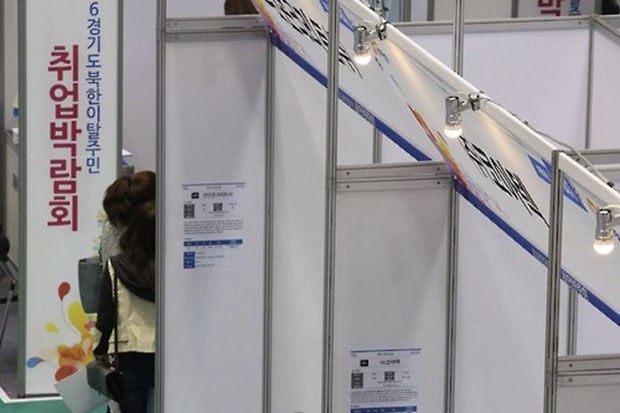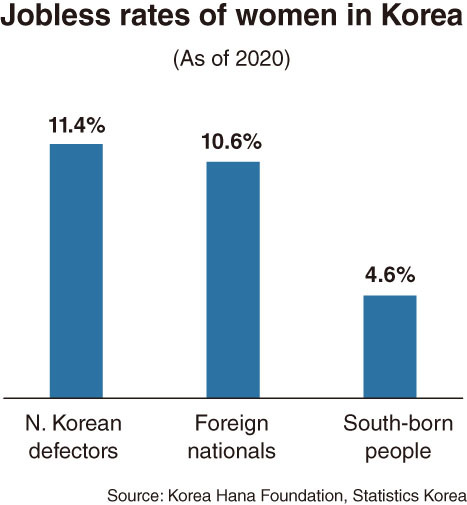[News Focus] Jobless rate for female NK defectors surges to record high
In unemployment rate, North-born women post higher than female foreigners
By Kim Yon-sePublished : May 25, 2021 - 15:35

SEJONG -- The pandemic has worsened hiring conditions for female defectors from North Korea, who already faced higher unemployment rates than male defectors and South Korean women who were born here.
According to the Korea Hana Foundation and Statistics Korea, the jobless rate for female North Korean defectors reached an all-time high of 11.4 percent in 2020.
Though unemployment had been relatively high among female North Korean defectors for years, until last year the rate never exceeded 8 percent. The figure stood at 7.7 percent in 2019, 7.6 percent in 2018 and 7.7 percent in 2017, when the nation officially started compiling the data.
In contrast, the unemployment rates as of December 2020 stood at 4.6 percent for South Korea-born women, 3.7 percent for South Korea-born men and 4.7 percent for men from the North (De facto jobless rates, which take underemployment into account, exceeded 10 percent for both men and women born in the South).
Furthermore, women under age 68 who were born in North Korea were more likely to be unemployed than foreign nationals residing here. The corresponding figures last year were 10.6 percent for foreign women and 6.1 percent for foreign men.

In the same vein, the employment rate for women from the North dipped below the 50 percent mark for the first time in 2020, posting 49.3 percent, in contrast with the 70.6 percent employment rate for male defectors.
A large portion of the female defectors had worked in the service industry, many in small businesses such as restaurants and pubs, which took a severe hit in 2020 from COVID-19. It appears that they were dismissed en masse.
Also, even before the pandemic female defectors on the whole were underpaid.
Data from the foundation showed that more than 3 in 5 female defectors, or 63.3 percent, were paid less than 2 million won ($1,770) per month in 2019.
Of all the employed women who were born in the North, 32.7 percent fell into the 1.5 million-2 million won monthly income bracket.
A further 16.5 percent earned between 1 million and 1.5 million won per month, 10.2 percent between 500,000 and 1 million won, and 3.9 percent less than 500,000.
At the higher end of the distribution, 30.8 percent made between 2 million and 3 million won per month and 5.9 percent brought in over 3 million won, but the average monthly wage for female defectors posted 1.752 million won in 2019.
By comparison, a full-time worker paid the nation’s statutory minimum wage would have brought in 1.745 million won per month that year.
Despite the sharp climb in the minimum wage -- from 1.35 million in 2017 to 1.57 million in 2018 and 1.74 million in 2019 -- average monthly wages for female defectors saw meager gains. For them, the figures inched up from 1.53 million won in 2017 to 1.65 million won in 2018 and 1.75 million in 2019.
The low salaries reflect, in part, the higher percentage of part-time or temporary workers among women born in the North. They also indicate that these women face significant hurdles to regular employment in the South.
The average monthly wage for male defectors was 2.78 million won in 2019.
Data showed that 8 out of every 10 men from the North were paid at least 2 million won per month. A further 41.1 percent earned 3 million won or more, and 42.2 percent made between 2 million and 3 million won.
By Kim Yon-se (kys@heraldcorp.com)





![[Herald Interview] 'Amid aging population, Korea to invite more young professionals from overseas'](http://res.heraldm.com/phpwas/restmb_idxmake.php?idx=644&simg=/content/image/2024/04/24/20240424050844_0.jpg&u=20240424200058)











![[KH Explains] Korean shipbuilding stocks rally: Real growth or bubble?](http://res.heraldm.com/phpwas/restmb_idxmake.php?idx=652&simg=/content/image/2024/04/25/20240425050656_0.jpg&u=)

